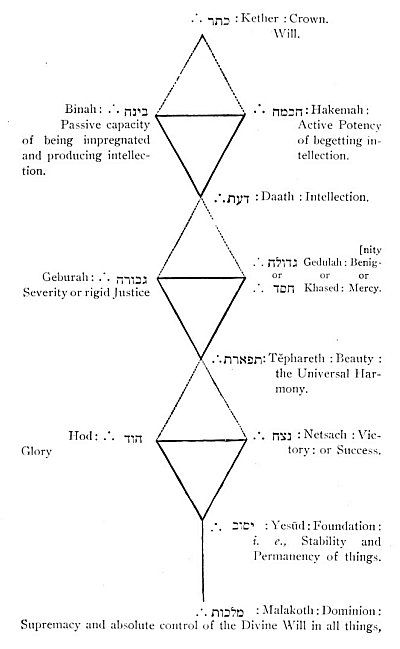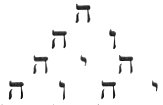The triple triangle, a figure of five lines uniting in five points, was among the Pythagoreans an emblem of Health.
It is the Pentalpha of Pythagoras, or Pentangle of Solomon; has five lines and five angles; and is, among Masons, the outline or origin of the five-pointed Star, and an emblem of Fellowship.
The number 6 was, in the Ancient Mysteries, a striking emblem of nature; as presenting the six dimensions of all bodies; the six lines which make up their form, viz., the four lines of direction, toward the North, South, East, and West; with the two lines of height and depth, responding to the zenith and nadir. The sages applied the senary to the physical man; while the septenary was, for them, the symbol of his immortal spirit.
The hieroglyphical senary (the double equilateral triangle) is the symbol of Deity.
Six is also an emblem of health, and the symbol of justice; because it is the first perfect number; that is, the first whose aliquot parts (1/2, 1/3, 1/6, or 3, 2, and 1), added together, make itself.
p. 635
Ormuzd created six good spirits, and Ahriman six evil ones. These typify the six Summer and the six Winter months.
No number has ever been so universally in repute as the septenary. Its celebrity is due, no doubt, to the planets being seven in number. It belongs also to sacred things. The Pythagoreans regarded it as formed of the numbers 3 and 4; the first whereof was, in their eyes, the image of the three material elements, and the second the principle of everything that is neither corporeal nor sensible. It presented them, from that point of view, the emblem of everything that is perfect.
Considered as composed of 6 and unity, it serves to designate the invisible centre or soul of everything; because no body exists, of which six lines do not constitute the form, nor without a seventh interior point, as the centre and reality of the body, whereof the external dimensions give only the appearance.
The numerous applications of the septenary confirmed the ancient sages in the use of this symbol. Moreover, they exalted the properties of the number 7, as having, in a subordinate manner, the perfection of the unit: for if the unit is untreated, if no number produces it, the seven is also not engendered by any number contained in the interval between 1 and 10. The number 4 occupies an arithmetical middle-ground between the unit and 7, inasmuch as it is as much over 1, as it is under 7, the difference each way being 3.
The number 7, among the Egyptians, symbolized life; and this is why the letter Ζ of the Greeks was the initial of the verb Ζάω, I live; and Ζεὺς (Jupiter), Father of Life.
The number 8, or the octary, is composed of the sacred numbers 3 and 5. Of the heavens, of the seven planets, and of the sphere of the fixed stars, or of the eternal unity and the mysterious number 7, is composed the ogdoade, the number 8, the first cube of equal numbers, regarded as sacred in the arithmetical philosophy.
The Gnostic ogdoade had eight stars, which represented the eight Cabiri of Samothrace, the eight Egyptian and Phœnician principles, the eight gods of Xenocrates, the eight angles of the cubic stone.
The number eight symbolizes perfection: and its figure, 8 or ∞ indicates the perpetual and regular course of the Universe.
It is the first cube (2 × 2 × 2), and signifies friendship, prudence,
p. 636
counsel, and justice. It was a symbol of the primeval law which regarded all men as equal.
The novary, or triple ternary. If the number three was celebrated among the ancient sages, that of three times three had no less celebrity; because, according to them, each of the three elements which constitute our bodies is ternary: the water containing earth and fire; the earth containing igneous and aqueous particles; and the fire being tempered by globules of water and terrestrial corpuscles which serve to feed it. No one of the three elements being entirely separated from the others, all material beings composed of these three elements, whereof each is triple, may be designated by the figurative number of three times three, which has become the symbol of all formations of bodies. Hence the name of ninth envelope, given to matter. Every material extension, every circular line, has for representative sign the number nine, among the Pythagoreans; who had observed the property which this number possesses, of reproducing itself incessantly and entire, in every multiplication; thus offering to the mind a very striking emblem of matter which is incessantly composed before our eyes, after having undergone a thousand decompositions.

Moe is the founder of GnosticWarrior.com. He is a father, husband, author, martial arts black belt, and an expert in Gnosticism, the occult, and esotericism.





